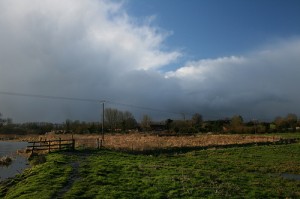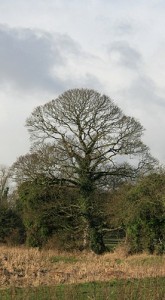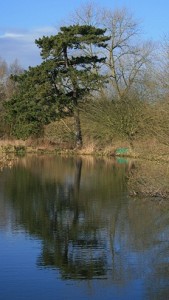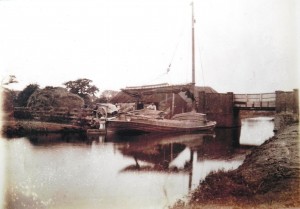Otters have a habit of putting in an appearance when you least expect them. It may be their natural inquisitiveness. This morning’s Otter was a case in point. All four of us were walking upstream on the Common. As usual there were several conversations going on at once, and whilst our attention was diverted, the Otter surfaced for a few seconds before submerging and leaving a trail of bubbles as it disappeared. But that few seconds was enough. We had been Otter-less, or at least lacking in sightings, for a few months. Perhaps they were not in the area or maybe they were keeping a low profile whilst rearing young. Now they were back. All we need to do is to not expect to see them, not worry about how much noise we make and then we should see them again.
-
A June Otter
-
Six cygnets
Six cygnets are being gently shepherded by their parents above the Mill Reach at Burgh. This may be a sign that the Otters are not in residence at the moment – it is possible that they have a liking for eggs, judging by last year’s low cygnet success rate. This morning the Swan family formed an ungainly parade as the followed the Mermaid downstream to the relative sanctuary of the flight pond.
-
Cuckoo courtship
The Bure was a near-perfect mirror as we crossed the Common. A cuckoo called from the Church Wood at Oxnead and, as we paused, the calls got closer. Then over the top of the slope of Limekiln Farm two Cuckoos appeared. Both unaware of our presence they settled on the top of the Island Willow. As they passed one uttered that curious contact call – something of a cross between a chuckle and a shake of dice – whilst the other continued the signature call. This was Cuckoo courtship.
All this activity reminded me of that Thomas Hardy line, “this is the weather the Cuckoo likes”, for it was. A finer blue sky had not appeared until today and to add to the poem’s picture the Chestnut near the Cradle Bridge was fully in flower.
-
Cuckoo arrives
At last a Cuckoo has arrived in the village. It is the morning of the 27th April, during a fine morning interrupted by early showers, it’s call drifts over the long meadow. The Bure is mirror-like. The Hawthorns are a fresh emergent green, the blackthorns in flower. Oak leaves are emerging and the grass is, at last, showing some good growth. The Cuckoo perches at the top of an a Hawthorn, with wings drooped down and head jutting it projects a call which changes subtly depending upon the distance of the listener. We first hear the whoop-woo from just a quarter of a mile
-
March Mermaid Kingfisher
This morning, as a gust from a cold easterly wind made us shudder into our coats, a high pitched exchange of notes rode the breeze upstream. The Mermaid was flowing over a riverbed which was seemingly devoid of life. But as we approached the calls became more frenetic and a pair of Kingfishers fled downstream before us. They continued their conversation, perched for a while on a suitable fence before whirring low and straight towards the Bure. Their colours almost shocking in comparison to the browns and greys of the meadows in March
-
Winter crowns

a sharp February hail storm heads south Hail from a passing squall stung our faces as we walked upstream from Oxnead. A reminder that we cannot take the arrival of the weak Spring sunshine for granted. As we pressed on the clouds moved southwards and the sun light broke through and created a dramatic contrast. Colour leaped from the highlighted trees and the shapes of their bare winter crowns gained new depth. Around the village
 the variety of trees gives texture to the landscape. a sycamore, so often
the variety of trees gives texture to the landscape. a sycamore, so often damned as a species, shows as a beautiful dome marking the edge of the ploughed lands and the start of the marsh. A Scots Pine sits over a gentle curve of the Bure, its reflection set with the pristine clarity of a Japanese print. Below the Hall Beech, Oak and the spiralling bark of the Chestnut provide an arboretum’s grandeur.
damned as a species, shows as a beautiful dome marking the edge of the ploughed lands and the start of the marsh. A Scots Pine sits over a gentle curve of the Bure, its reflection set with the pristine clarity of a Japanese print. Below the Hall Beech, Oak and the spiralling bark of the Chestnut provide an arboretum’s grandeur. -
White heron
A small white heron is a regular winter visitor to Brampton’s grazing meadows. The Little Egret used to be relatively uncommon in Norfolk and it’s visits in the 1960’s caused excitement in the bird watching fraternity. Now it seems to have suffer the curse of the commonplace – it is no longer rare enough to create the same level of excitement. However, it is a welcome guest to the water meadows here. It’s white plumage standing out in the Wintery greys and greens of the Meadows along the Mermaid river. The Egret’s yellow feet contrast strongly with it’s mainly black legs. It can be seen resting in a tall Ash tree or stealthily fishing in the river margins. Occasionally a second Egret appears on the scene. This usually signals the coming of Spring and the time to move back to the coast, perhaps to the breeding colony at Holkham.
-
Clear water
This morning the Bure was beautifully transparent. Many Brown Hawker dragonflies hunt in the air around us as we glide downstream. At the confluence with King’s Beck, a Kingfisher called and whirred its way past us. In the river itself, groups of Whirligig Beetles live up to their name, whilst below Pike gave themselves away by the gentle flutter of their pelvic fins and the cruel stare of their hunter’s eye. At Bream Corner one large specimen hangs in the slow current as we pass by and then slips imperceptibly to the sanctuary of a deep weed bed. The Canoe Man shepherds a party of canoeists up to Oxnead – the party a picture of enjoyment and first-time exploration
-
On an Otter’s trail
There is a distinct pattern of bubbles that mark the trail of a submerged Otter. They burst at the waters surface and mark the route of an agile mammal moving at some speed. This evenings were typical; swimming at what must have been no more than say a foot’s depth, where the River Mermaid joins the Bure, the line of bubbles was a like row of silver coins – each a few inches apart in a curving trail under the footbridge. The Otter kept submerged until the safety of the overhanging willow where it invisibly surfaced before diving to the sanctuary of the deeper waters of the Bure. We waited to see if would return, perhaps racked with the supposed curiosity of mammals of this type, but it had obviously seen enough of us and had retired out if sight.



